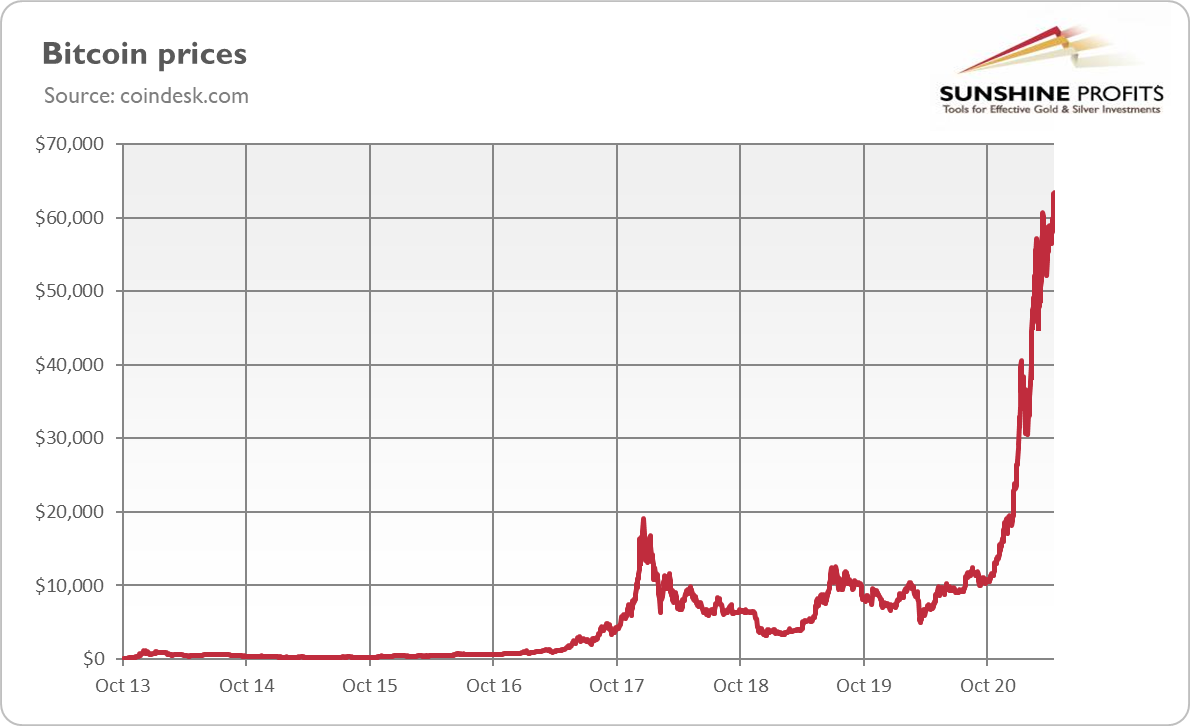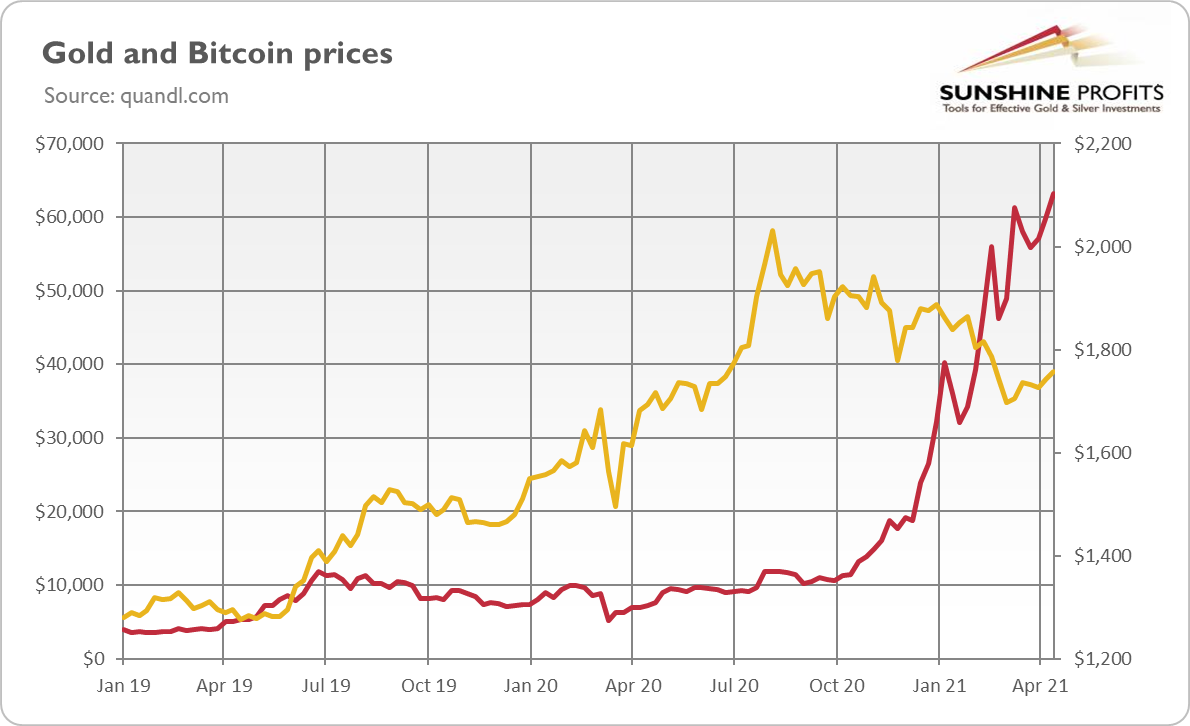Please log in to read the entire text.
If you don’t have a login yet, please select your access package.
Note: This article was written just before this week’s most recent plunge in cryptocurrencies, however, the general principle still applies. Cryptos can still play a parallel role to precious metals, but are not necessarily their substitute. Furthermore, the most recent exodus in cryptos and subsequent price drop is most likely just a temporary dip. The general trend still points to the upside.
Bitcoin’s popularity and price are rising. However, cryptocurrencies could be seen as complementary, not substitutive to gold.
What a rally! Unfortunately, I’m not referring to gold, but to Bitcoin. As the chart below shows, the price of the first and the biggest of cryptocurrencies rose to above $60,000 in April 2021 from scratch (or $124) in October 2013 when the chart starts. I wish I had bought more coins in these early years of cryptocurrencies and held them for longer! More recently, Bitcoin has skyrocketed almost 1200% from its bottom of $4,945 during the asset sell-off in March 2020.
OK, but why am I writing about Bitcoin in the Gold Market Overview? The reason is the narrative that the cryptocurrency has already become or will become soon the substitute for gold. Some people even call Bitcoin “new gold” or “millennial gold”. And this is what Jerome Powell has recently said about cryptocurrencies:
Crypto assets are highly volatile and therefore not useful as a store of value. They are not backed by anything. It is a speculative asset that is essentially a substitute for gold rather than for the dollar.
Others echo Powell’s remarks, claiming that Bitcoin is displacing gold as an inflation hedge, or that it could supplant gold as a safe-haven asset. Are they right?
Well, there are, of course, some similarities between Bitcoin and gold which make these two assets substitutes to some extent. It would be surprising if that wasn’t the case, given the fact that Bitcoin’s system was designed to mimic the gold standard. In particular, there is a cap on the number of bitcoins to make this cryptocurrency rare just like the yellow metal. In other words, the idea is to make its supply inflexible, just as – or even more – in the gold standard. So, both Bitcoin and gold are anti-inflationary currencies whose supply cannot be arbitrarily changed like in the case of national fiat currencies. And both these assets have a libertarian, anti-government flavor – in the sense that demand for them stems from the lack of confidence in the government monies.
However, there are also important differences between Bitcoin and gold. First of all, although Bitcoin is believed to be an alternative anti-fiat asset, it’s actually also fiat money. It’s a private, decentralized, non-governmental currency, but it doesn’t change the fact that Bitcoin is not backed by anything, and it has no intrinsic value. Of course, value is subjective, but gold has some non-monetary use (in jewelry or technology), which implies that its price is not likely to drop to zero in a worst-case scenario in which people cease to see gold as a monetary asset. Unlike the shiny metal, Bitcoin has only monetary value – i.e., you cannot use it either as a consumer good or as an input in a production process – so there is no floor below its price (if the officials try to ban Bitcoin, its price could plunge really deeply).
Second, Bitcoin is much more volatile than gold. Sure, it might be just a problem of Bitcoin’s young age. But it doesn’t change the fact that price declines in the cryptocurrency are a few times bigger than in the gold market. Hence, although – thanks to the network effects and speculative appeal – Bitcoin offers potential for quicker and larger gains, it’s also associated with higher downward risks. It makes the cryptocurrency an inferior store of value and a safe haven. So, Bitcoin could be seen rather as a risky asset, not necessarily a safe haven that goes up together with risk appetite. This may explain the recent divergence in cryptocurrencies and gold.
What does it all mean for the gold market? Well, it’s true that some money has flowed from gold into Bitcoin and that some investors may prefer now to treat Bitcoin as a major alternative asset in their investment portfolios. However, such flows and rebalancing of portfolios as we’ve seen recently are perfectly normal, especially given that Bitcoin is still benefiting from the network effects, i.e., the accelerating institutional interest and mainstream acceptance.
More importantly, there are important differences between gold and Bitcoin, which imply that the latter won’t replace the yellow metal. The correlation coefficient between the weekly prices of these two assets is only 0.38 percent, so they are really far away from being perfect substitutes. Also, please take a look at the chart below which shows their prices in 2019-2021.
As you can see, gold reached its peak in early August, while the rally in the cryptocurrency started in October, two months later. Hence, it should be clear that Bitcoin didn’t cause the plunge in gold prices. We could even hypothesize that gold has undergone (or is undergoing) a healthy correction, which is still ahead of Bitcoin. After all, its price chart looks parabolic, which brings to mind the possibility of a bubble (although network effects can be partially responsible for this shape).
Anyway, for us, these two assets are rather distinct despite all the similarities. And they both can coexist together as hedges against national fiat currencies, as they complement each other. Bitcoin can be used in instant payments, cross-border payments and as a highly risky speculative asset, while gold has non-monetary value and provides long-term stability. But Bitcoin’s rise in popularity doesn’t pose an existential threat to gold. After all, the yellow metal has an exceptional track record of being the ultimate money, proving its value over millennia.
Thank you for reading today’s free analysis. If you enjoyed it, and would you like to know more about the links between the economic outlook, the current (past?) crisis and the gold market, we invite you to read the May Gold Market Overview report. Please note that in addition to the above-mentioned free fundamental gold reports, and we provide premium daily Gold & Silver Trading Alerts with clear buy and sell signals. We provide these premium analyses also on a weekly basis in the form of Gold Investment Updates. In order to enjoy our gold analyses in their full scope, we invite you to subscribe today. If you’re not ready to subscribe yet though and are not on our gold mailing list yet, we urge you to sign up. It’s free and if you don’t like it, you can easily unsubscribe. Sign up today!
Arkadiusz Sieron, PhD
Sunshine Profits: Effective Investment through Diligence & Care.
-----
Disclaimer: Please note that the aim of the above analysis is to discuss the likely long-term impact of the featured phenomenon on the price of gold and this analysis does not indicate (nor does it aim to do so) whether gold is likely to move higher or lower in the short- or medium term. In order to determine the latter, many additional factors need to be considered (i.e. sentiment, chart patterns, cycles, indicators, ratios, self-similar patterns and more) and we are taking them into account (and discussing the short- and medium-term outlook) in our Gold & Silver Trading Alerts.





